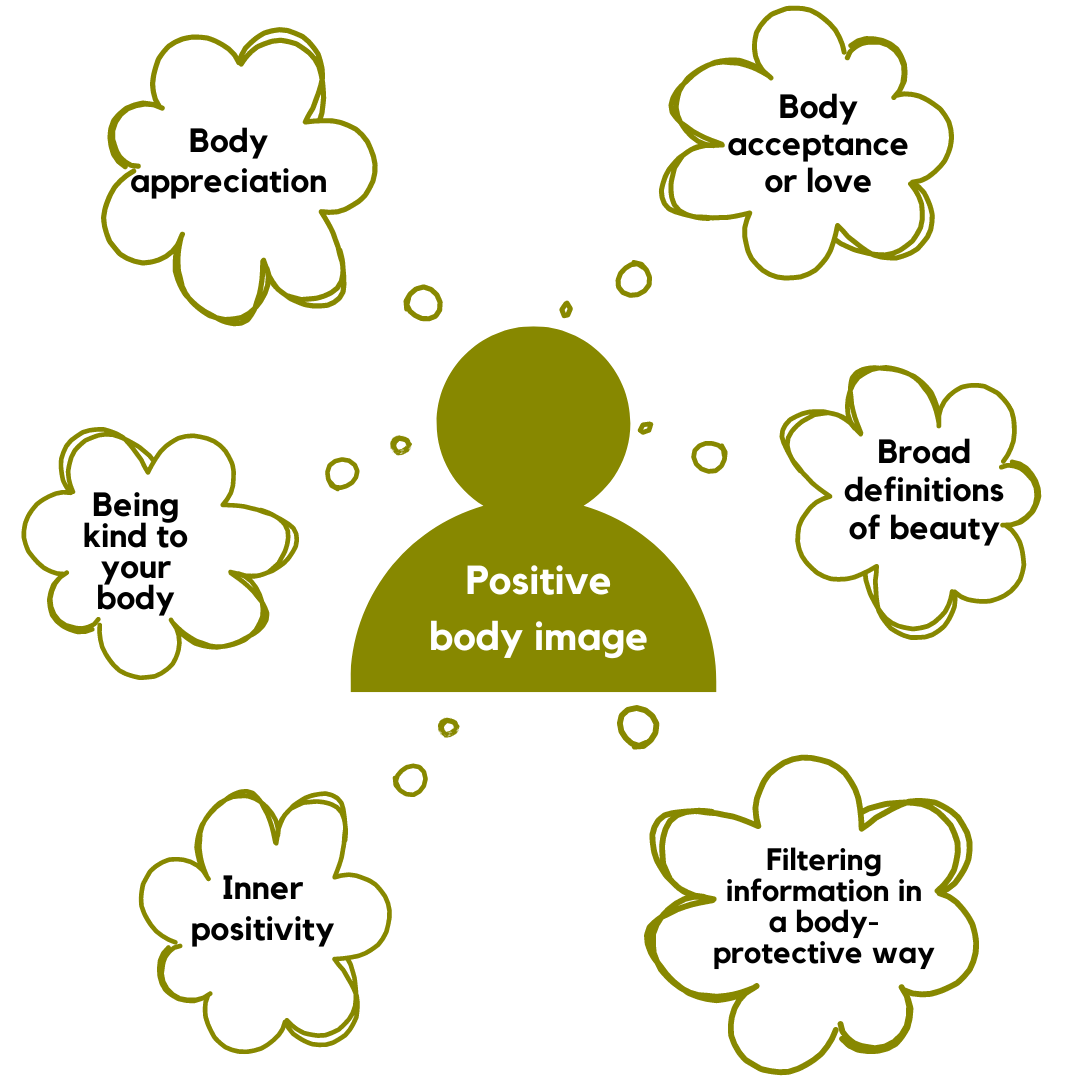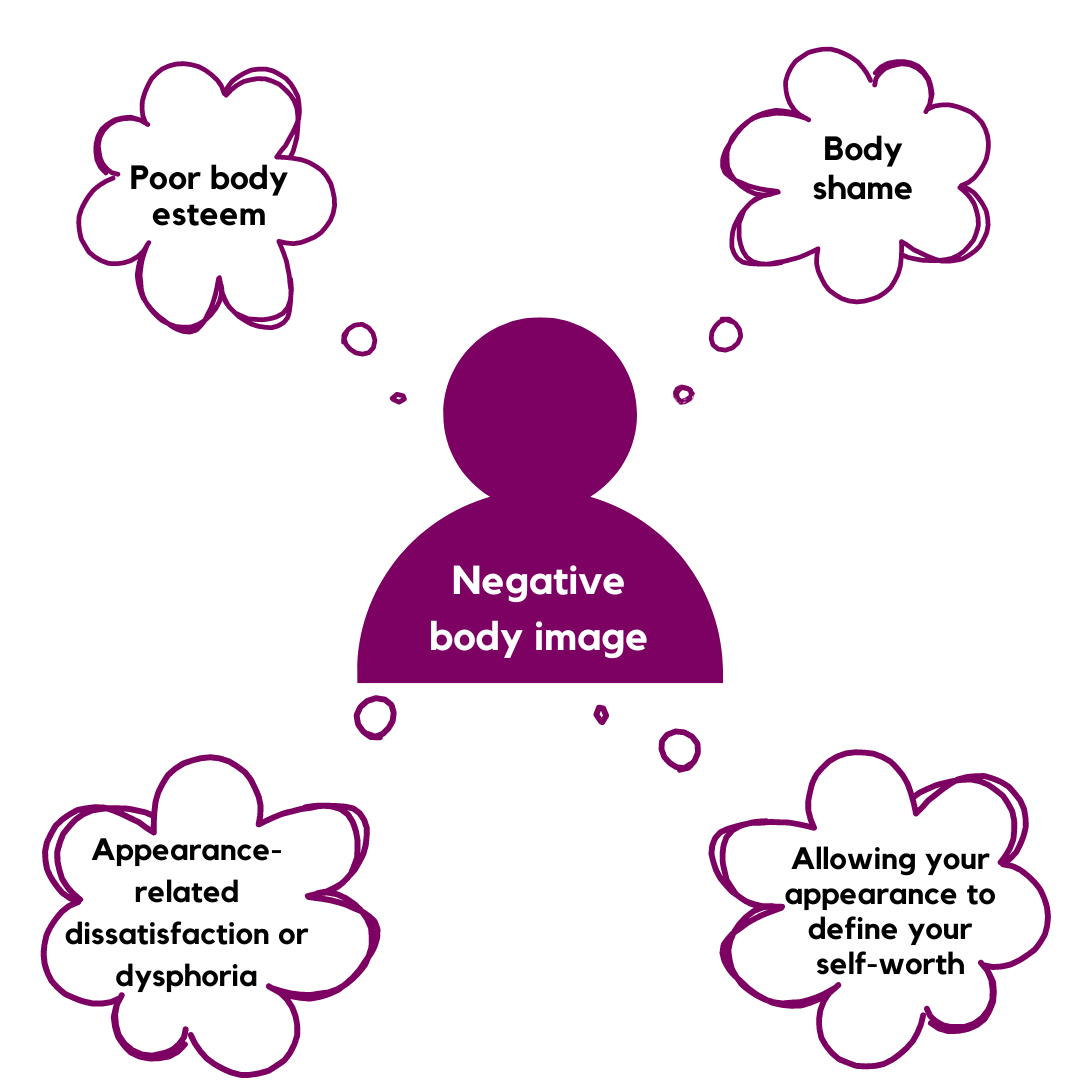
Body image refers to the thoughts, beliefs, feelings, and behaviours you hold toward your body (Cash, 2004). Body image can be broken down into two distinct features: positive body image and negative body image.
Self-esteem is the "real" opinion you have of yourself: how you value and respect yourself as a person. Your self-esteem has a direct effect on how you take care of yourself, emotionally, physically, and spiritually. Self-esteem and body image also exert influences on each other – it is hard to feel good about yourself if you hate your body.
It is important that we continue to embrace body diversity and promote positive body image for individuals of all ages, genders, sexual orientations, abilities, and racial and ethnic backgrounds.
Positive body image is made up of six distinct characteristics (Tylka & Wood-Barcalow, 2015):


Negative body image can be conceptualized as (Cash et al., 2004; Gattario & Frisen, 2019):
Model a healthy lifestyle. When others see you eating well and being physically active in a normal, ongoing way, without preaching or over-emphasis, they will accept these behaviours as normal. You can be a role model to guide them.
Remind people how to identify symptoms of stress: Shallow, fast breathing; sweaty palms; racing heart; headaches or stomach-aches; a panicky sensation. Suggest things to do to calm down.
Model and teach ways to deal with stress and conflict: Deep breathing, progressive relaxation exercises, a solitary walk, quiet time alone, listening to or playing music. You can also teach ways to deal with stressful situations, such as:
Help others to develop self-esteem based on qualities other than physical appearance: Comment on and affirm characteristics that are not related to someone's body. Be specific with your compliments:
Don't ignore negative comments about physical appearance, including size, shape, cultural dress or race. Do not allow belittling remarks based on racial, sexist or other stereotypes. Use them as teachable moments without shaming anyone.
Teach critical thinking skills. Help others learn to analyze, synthesize, apply, and evaluate.
Teach about aspects of self and life that one can influence, and help people feel stronger and more able to cope.
Get rid of your diet and get rid of your scale! Listen to your body. Let it tell you how healthy you are. Remember that your weight is not a measurement of your health or self-worth. Make health and vitality your goal, not a specific weight. Learn about the Health at Every Size® philosophy.
Avoid labelling food "bad," "sinful," or "junk". Labels like this can make you feel guilty or ashamed for eating "bad" food. If we think this way, we might restrict certain foods, then end up bingeing on them. Try to use neutral language when thinking and communicating about food; as much as possible, when referring to a specific food or type of food, simply use its name (e.g., fruit, dairy products, candy) or words that describe its sensory characteristics (e.g., crunchy, salty). A healthy approach to eating includes regularly consuming nutrient-rich foods and giving yourself permission to enjoy foods that perhaps are lower in nutrients and higher in calories.
Do not encourage or laugh at jokes that make fun of a person's size or body. Find a direct and gentle way to say that a person's worth and morality are not related to how they look.
Criticize the culture that promotes unhealthy body image, not your self. Look at how encouraging people to dislike their bodies helps to sell products. Even young children can understand this. Encourage children to question, evaluate and respond to the messages that promote unhealthy body image and low self-esteem.
Celebrate Eating Disorder Awareness Week (EDAW) and International No Diet Day (INDD) in your community. Visit our events page to see if there are activities planned in your area.
Children develop their beliefs and behaviours from the adults that they love and respect. You can make a positive difference to the children in your life.
Teach children that their self-worth is not related to how they look. Emphasize their talents and qualities. Don't focus on their physical appearance.
Give children healthy choices, and teach them to make informed decisions about what they eat. Involve them in planning meals, shopping and cooking.
Emphasize the positive aspects of healthy eating, rather than focusing on the effects of unhealthy eating.
Do not use food as a reward or punishment. If you use food as a reward or comfort, or if you restrict food as a punishment, you are sending the message that food leads to love and acceptance. This may encourage children to seek out food for comfort or self-punishment.
Encourage children to take responsibility for their own well-being. This will help them learn to listen to their bodies.
Remind them to eat when they are hungry and stop when they are full.
Make your family meals a peaceful time for enjoying food and talking with each other. Save arguments, TV shows, telephone calls and difficult decisions for another time.
Live with a positive attitude to body image, not with a focus on food and weight. Show how you can be happy, healthy and active at any body size. Avoid complaining about your body, particularly in front of children. Don't talk about diets, calories and weight.
Model a healthy lifestyle.
Encourage self-awareness and critical thinking skills. These will help children evaluate new information using their own values, strengths and needs. Children who can do this are more likely to resolve their problems in healthy ways rather than by using food and weight manipulation as coping strategies.
Be aware of advertising and toys aimed at children. Notice how they reinforce gender stereotypes and body dissatisfaction. Encourage a conversation about how the child in your care views the advertisement or the toy. Foster critical thinking and playfulness.
Work toward identifying and resisting all forms of discrimination. Remember that prejudice against size and body relates to prejudice based on gender, race, sexuality, class and physical ability.
We live in a world where it can be hard to avoid the messages that the media perpetuates. However, there are some tools and strategies that you can use to filter and critique the messages and content you consume in the media (Coughlin & Kalodner, 2006; McLean et al., 2016; National Eating Disorder Collaboration, n.d.):
Understand, question, and evaluate the use of Photoshop, photo manipulation/editing, and filters. Critique whether what you are seeing reflects realistic portrayals of social reality and real bodies.
Understand and identify how marketing, sponsorships, partnerships, and advertisements influence media messages about beauty, health, and appearance. Question what the people who made the media message want you to believe, and whether they gain or profit from the message they are putting out.
Critique the media’s objectification of bodies and emphasis on tying physical appearance to self-worth. Evaluate whether the media acknowledges the biological limitations on changing body size and shape, as well as the natural distribution of weight. Reject dominant narratives about tying appearance to self-worth and identify positive qualities that are not tied to weight and physical appearance.
Critique how the media shapes societal notions about beauty, health, and appearance. Reflect on whether there is body diversity and representation (e.g., size, race, ethnicity, gender, abilities) in what you are seeing. Criticize whether the thin-ideal, fatphobic content, or binary gender expression are being perpetuated.
Create personal social media boundaries. Block, mute, or unfollow content that does not foster positive body image. Adapt your social media settings (e.g., time limit, privacy settings) to your preferences or needs.
Furthermore, there are a couple of NEDIC resources you can consider: